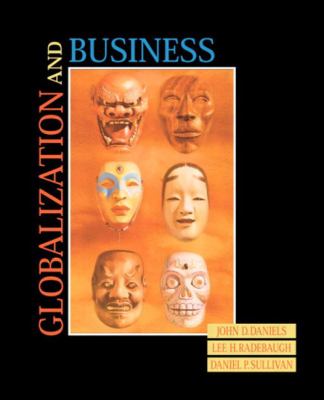139236
9780130620309
Globalization and Business
by John D. Daniels, Lee H. Radebaugh, Daniel P. Sullivan
Product details
- ISBN-13: 9780130620309
- ISBN: 0130620300
- Publication Date: 2001
- Publisher: Prentice Hall
AUTHOR
SUMMARY
We began writing a survey international business text about thirty years ago, and that text has successfully reached its ninth edition. So, you may ask "Why have you now written a second survey text?" We have two reasons: (1) Student audiences have broadened, creating a need for a shorter text in addition to the ;traditional longer ones; and (2) Many universities now require that professors use different texts for undergraduate and graduate courses, creating a need for different approaches at the two levels. We'll now elaborate on these two points. First, when we began writing some thirty years ago, most students taking a survey international business course were upper level undergraduates or MBA students. Although this is still true, student audiences have been expanding both downward and upward. On the downward side, more junior colleges and community colleges have been offering survey international business courses. Many of their students lack the business and economics backgrounds that we assume for students plowing through our ninth edition text of about 800 pages. Further, they frequently lack both the time and background to analyze the short cases we have included at the end of all twenty-one chapters. Clearly, they need a text that is broad enough to cover the issues, but short enough so that they can absorb all the concepts. On the upward side, more business schools have been offering international business or international management courses within executive MBA programs. Professors teaching these courses generally depend more on projects and applications of materials than on lectures and presenting new terms and concepts. They depend on such tools as long comprehensive cases, industry and company analyses, scenario developments, and comparison of countries for business expansion. Given the time demands of working on projects, particularly when students typically work full time, there is little chance for students to cover a long text. Further, executive MBA students find much of the material from longer texts is superfluous because they deal with the issues regularly. Yet, they need shorter readings to synthesize major concepts so that they have a common framework for more orderly class discussions. Fortunately, the same synthesized shorter text version seems to be ideal for both the bottom-end and top-end of course levels. Although this seems incongruous, we have found a similar relationship for texts in other business courses. Second, universities are increasingly requiring the use of different texts at the undergraduate and graduate levels. The reasoning behind this requirement is understandable, particularly if a school admits most of its MBA students from its own undergraduate business program, because students may otherwise get credit for taking essentially the same course twice. But, many professors teach at both the undergraduate and MBA levels and prefer one set of authors' viewpoints and priority of coverage over others'. This creates a dilemma for them because they may have to use a text by an author whose viewpoints differ from their own. Thus, we have maintained the same viewpoints and essential coverage from our longer text in this shorter text. As a result, we believe that professors can satisfactorily use one of our texts at one level and the other at the other level. They can further differentiate the courses through projects and additional materials. When we decided to write a shorter text, we were tempted simply to abridge what was in our longer text. That would certainly have saved time, but we feel strongly that a shorter text needs a fresh and very different approach. Although concepts and viewpoints remain essentially the same between the two texts, we have reorganized materials completely. We have gone from 21 t0 14 chapters, and we have reduced the length of each chapter by about one-gird. Rather than simply eliminating some chapters or combining some of them, we startedJohn D. Daniels is the author of 'Globalization and Business', published 2001 under ISBN 9780130620309 and ISBN 0130620300.
[read more]



